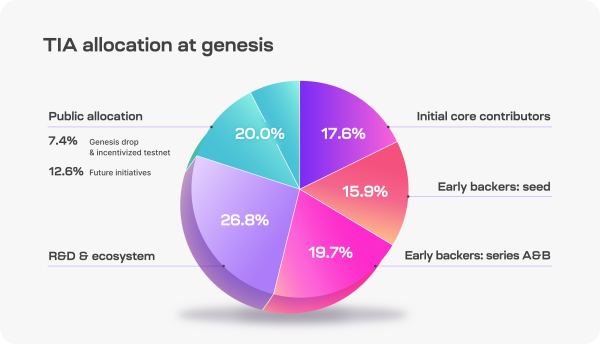
As the first modular blockchain network, Celestia is leading a new trend in blockchain technology. As Celestia's native asset, TIA not only plays an important role in payment and governance in the network, but also provides developers with an efficient and flexible development environment. This article will analyze various aspects of TIA in depth to help you fully understand this important asset.
TIA Overview
Abbreviation: TIA
Initial Supply: 1,000,000,000 TIA
Inflation Plan: The inflation rate in the first year is 8%, and then decreases by 10% each year until the annual inflation rate reaches a bottom line of 1.5%.
Decimal Places: 6
Conversion Rate: 1 uTIA = TIA × 10^-6
The Role of TIA
Payment Data Space
TIA, Celestia's native asset, is the key for developers to build applications on this modular blockchain network. In order to use data availability on Celestia, Rollup developers need to submit PayForBlobs transactions and pay the corresponding fees, which are denominated in TIA.
Launching a New Rollup
One of Celestia's visions is to make deploying a blockchain as easy as deploying a smart contract. In the era of modularity, developers no longer need to issue their own tokens to launch a blockchain. Similar to ETH on Ethereum, developers can choose to use TIA as a fuel token and currency to quickly launch their chain. In addition, TIA can also be used to pay for data availability, allowing developers to focus on creating their application or execution layer without issuing tokens immediately.
Technical Foundations of TIA
Proof-of-Stake
As a permissionless network built with the Cosmos SDK, Celestia uses Proof-of-Stake to ensure the security of its consensus. Like other Cosmos networks, any user can help secure the network by delegating their TIA to Celestia validators and receive part of the validator's staking rewards.
Decentralized Governance
The staking of TIA also allows the community to conduct decentralized governance in key parts of Celestia, such as voting on network parameters through governance proposals, and managing the community pool (which receives 2% of block rewards).
utia: Staking Unit
utia is the staking unit, which stands for "micro TIA", 1 TIA = 1,000,000 utia. In staking operations or transactions, if no unit is specified, utia is used by default.
microtia: Staking Unit Alias
microtia is an alias for utia, which is the alias used in staking operations.
Payment Data Space
PayForBlobs Transaction
In order to publish data on Celestia, developers can submit PayForBlobs transactions. A PayForBlobs transaction includes the identity of the sender, the data to be published, the size of the data, the namespace, and the signature. Each PayForBlobs transaction is divided into two parts: a blob or blobs containing the data and the namespace, and an executable payment transaction containing a commitment to the data. These blobs and executable payment transactions are placed into blocks within the appropriate namespace. The block data is extended using erasure coding and then Merkelized into a data root commitment included in the block header.
Conclusion:TIA, as the native asset of Celestia's modular blockchain network, plays multiple roles such as payment, staking and governance. It not only provides developers with an efficient and flexible development environment, but also ensures network security and community participation through proof of stake and decentralized governance mechanisms. By deeply understanding various aspects of TIA, we can better understand Celestia's innovation model and future development potential.